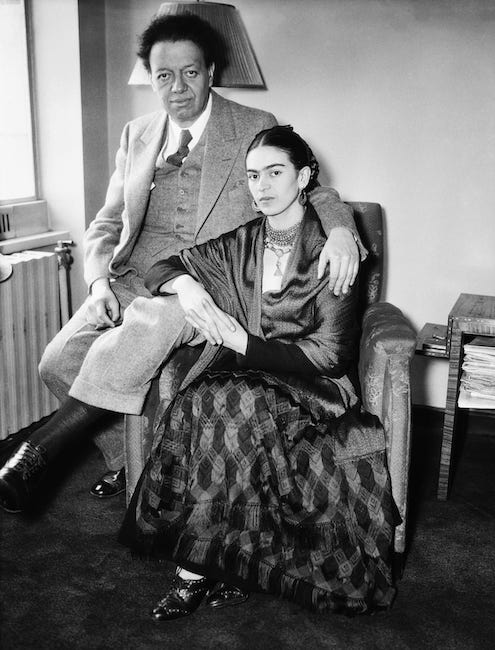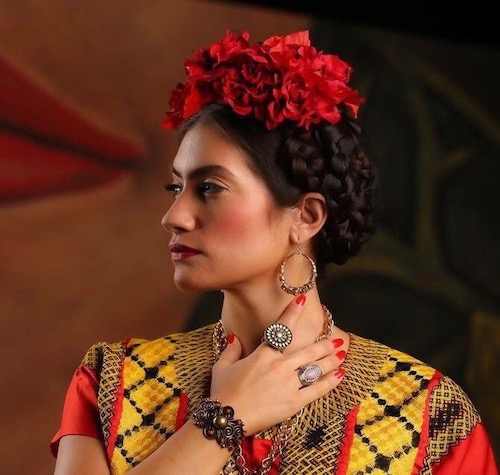Artists’ turbulent love affair takes the stage in FGO’s “Frida”

The relationship of artists Frida Kahlo and Diego Rivera will be painted in the opera “Frida,” which opens Saturday in Miramar, presented by Florida Grand Opera.
The opera stage is where passions, conflicts, and destinies that are too large for the course of everyday life play out. But every once in a while, real life can exceed the world of opera.
One life that can barely be contained by the form is that of Frida Kahlo, the great Mexican artist. Her paintings told the story of her life, which was full of physical and emotional pain, the joys and turmoil of her canvas-sized relationship with her even more celebrated contemporary, Diego Rivera.
In 1991, composer Robert Xavier Rodriguez brought forth his biographical opera, Frida. Premiered in Philadelphia by the American Music Theater Festival, the work was revised in 1993. Beginning Saturday night, Florida Grand Opera will present seven performances of Frida, in a 2015 production from the Michigan Opera Theater.
Soprano Catalina Cuervo has become the leading exponent of this role, from the birth of this current production in Detroit through a 2017 revival with the Cincinnati Opera.
The composer was substantially responsible for getting her into the title role. “I met him in 2013 when Florida Grand Opera was doing a double bill of [Astor Piazzolla’s opera] Maria de Buenos Aires” and Rodriguez’s Tango. “He asked me to do the role, he thought I was perfect, and he recommended me to MOT.”
Kahlo’s importance goes way beyond her work. She is an icon in Latin cultures throughout the world, and that status resonates with Cuervo. “Obviously I am Latin, but not Argentinian or Mexican,” says the soprano who was born in Columbia, “but we are all connected through Spanish culture.”
“Frida really represents all women of Mexico, and the way Mexicans celebrate their culture.”
Cuervo says she “prepared more for this role than any other of my life.” That included a heavy dose of biographical research that began with Hayden Herrera’s definitive book on Kahlo as well as traveling “I went to her house!” Cuervo says, “the Detroit Institute of Arts sent me videos of Rivera pointing out the murals in the DIA, videos of Frida and Diego’s time living there. The opera is based on [Herrera’s bio], basically.”
With her extensive preparation—including studying traditional Mexican dances—Cuervo says she feels “very secure in this role. I feel more secure about the music, which can be challenging.”
The main difficulty, says the singer, is in how Rodriguez asks the singer to use two different voices—head and chest voice—to express both different dramatic situations and musical styles.
“The tessitura is in the right spot for soprano,” explains Cuervo, “all the way up to high F and G. There are complete arias in chest voice, then in head voice, and a lot of talking,” that advances the plot in the way of operetta or musicals. The head voice is mostly used for “happy music,” while the chest voice “is like a musical theater piece. He almost composed it for a mezzo and a soprano” in one singer.
Bass-baritone Ricardo Herrera sings Diego Rivera. As with Cuervo, this is the singer’s third time in the role, since debuting the current production in Detroit in 2015.
“There are several charming things about the role, and there are challenges as well,” he says. One of them is not vocal, but physical.
Rivera was a larger-than-life presence, nothing like the more slender bass-baritone. At the audition for the role, “they loved my singing, but said ‘the only problem is you are a little too thin!’” The solution was extra padding that Herrera wears to make himself larger, but which can be tough to bear over the course of even a short opera, “It is hot!”
Rodriguez’s music, he found to be a much more comfortable fit.
“Musically, the opera is well put together,” says Herrera. ‘There is music theater with the opera, there’s jazz when Diego and Frida are on their New York trip, when Nelson Rockefeller sees Diego’s mural,” Man at the Crossroads, for the lobby of 30 Rockefeller Plaza.
While Rockefeller had approved of the mural’s general theme of conflict between capitalism and communism, he demanded that Rivera remove a depiction of Lenin. The artist refused, and so the unfinished mural was first plastered over, then eventually peeled off the wall and destroyed.
“A lot comes across in [the staging’s use of] their paintings.” Part of the production takes one of Kahlo’s most famous, beautiful, and mysterious works, The Wounded Deer, a picture of a stag shot through with arrows, its head replaced by Kahlo’s, and realizes it through choreography.
Herrera explains that the story goes “from the time they met, to when Rivera became famous. It’s an exciting role, a unique role.” Like Kahlo, Rivera is a culture giant in Mexico; growing up and going to school there, says Herrera, all children were taught about both artists.
Herrera finds that musically, “the opera is well put together, there are many moments of tenderness, and a lot of fighting” between Kahlo and Rivera. Brought together by time, place, art, and nationality, the two seemed destined to be partners, but their relationship ultimately could not survive due to the stress of two dominating personalities.
“When you are so close to the history of your country,” Herrera adds, singing Rivera “is a very exciting role, a unique role.”
Florida Grand Opera’s Frida opens 7:30 p.m. Saturday and runs through March 29. March 16 and 17 performances are at the Miramar Cultural Center; the show moves to Miami-Dade County Auditorium (March 21, 23 and 24) and then the Parker Playhouse in Fort Lauderdale (March 28 and 29). fgo.org
Posted in Articles
Leave a Comment
Thu Mar 14, 2019
at 3:04 pm
No Comments







